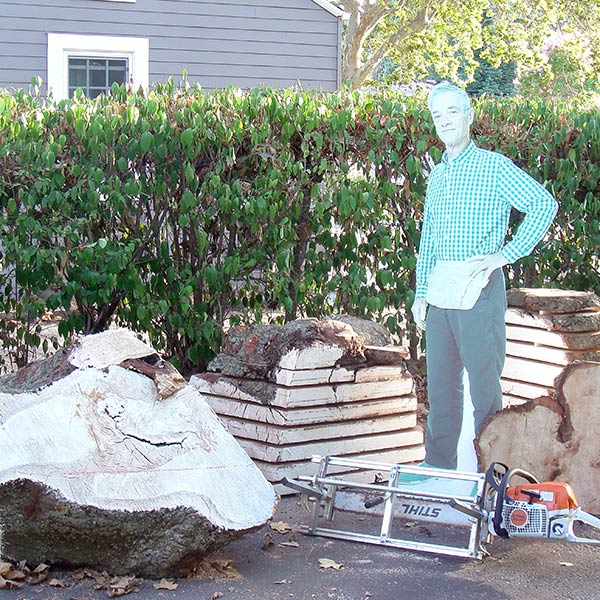I have known this engineer for years and assume that he would rather save an oak tree than cut it down, but this one was apparently growing in the wrong place. However, he noticed that it was a very unusual tree and thought the wood might be something special, so he called me. In fact, there was no real trunk. As the second photo shows, the base of the tree showed irregular branching right at the ground, and it was dominated by several of the roundish knobs which are referred to as burls and are much prized by woodworkers for their irregular and dramatic figure.
Thanks to the engineer’s timely call, we were able to salvage most of the burly wood around the bottom when the tree came down. It arrived at our shop in four large sections, all in one dump truck load, and Evelyn remembers that when they hit the driveway they made the house shake.

The next picture I took a couple of months later, after investing some time in milling the burls into slabs. A cardboard image of me poses with the milled slabs, which I cut using the chain saw mill lying in the foreground. The large unmilled piece on the left turned out to be too large for our equipment, so it became a rustic bench in our backyard. However we were able to process the rest into a batch of about 20 slabs, here stacked neatly behind my alter ego.


The next picture shows the milled slabs in October, stickered and covered for air drying. They stayed there, subject to periodic checks of moisture content, for most of three years, until I was convinced that the moisture content was down to 14% throughout. That’s good enough to start making furniture out of the wood, but in the meantime I had found insect damage. Green wood is especially prey to that; and coast live oak is one of the oak species that are relatively susceptible to insect damage. So these burls had become home to a collection of powder-post beetles, of both the “true” and “false” varieties.
These insects make their way through the wood, leaving small channels which exit the surface here and there. The wood was not seriously compromised by their activity – in fact, the holes are visually interesting and add to the already complex character of the wood – but I didn’t want the critters in the wood any more. So I spent some time exploring options, first kiln drying – that would have worked but at the cost of warping the wood, in effect throwing the baby out with the bath water – and then fumigation. We brought the burls to a fumigator in Oakland who was able to help us. He assured us that the insects would not return, and six months later I can attest to the accuracy of that.
We selected one of the slabs – actually the thick one in the middle of the stack right behind my left knee in the picture – and, after milling it flat, repaired the insect damage with clear epoxy, which polishes up to a transparent surface. This we shared with visitors to Open Studios Napa Valley in September 2018, as we explored how to turn it into furniture. The next pictures show what we came up with.


The finished table is a meditation on the burl that forms the top. It is, first, a token of the live oak tree; it recalls the wild figure and irregular shape of the burl that was part of this particular tree that stood in a Napa oak savanna. At the same time, it is by extension an emblem of the environment, the larger community humans are part of, including not only the tree but also the insects that left their mark on the wood, etc. One could say, of course, that any object made of wood reminds us of the natural source of the material, but in this case the connection is particularly vivid.
At the same time, the delicate regular geometry of the base adds an entirely different sort of meaning: in its dynamic opposition to the rough irregularity of the top, it recalls the dynamic opposition between human interventions in the landscape and the elements of the environment that stand in our way. In this case, the base is inspired by the semi-circular shape that the slab approximates to. If our design is successful, it will provide a dramatic foil to the irregular top.
I will close with one last view of the piece, showing the interplay of surfaces along the long side: the polished vertical side of the slab top opposes the base in an ironic way, seeming to propose a different regular geometry.



0 Comments